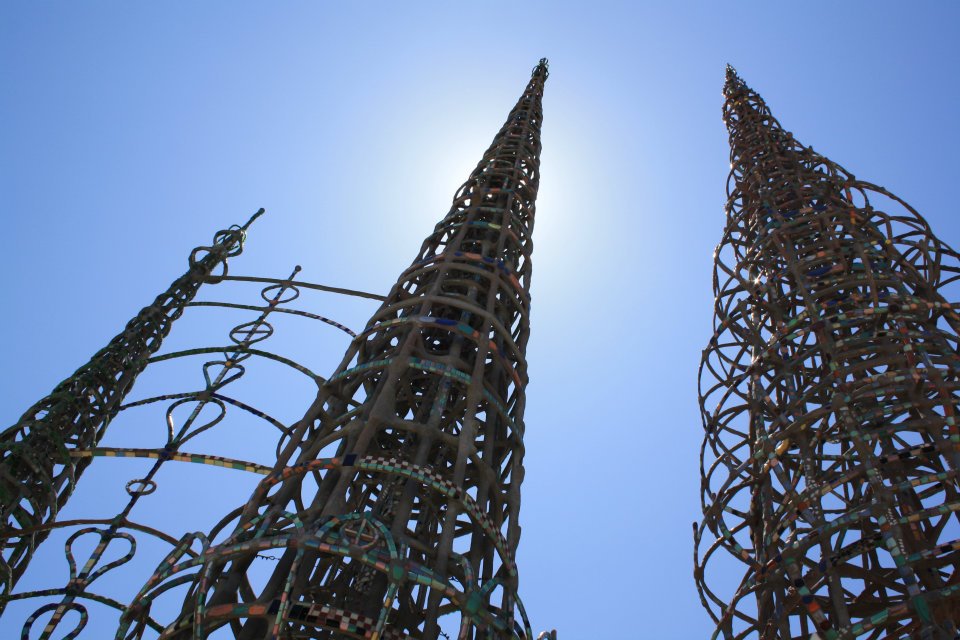Watts Towers
The Watts Towers are an installation of sculptures, towers and walls located in the Watts area of Los Angeles, California. They were built single-handedly by local resident Simon Rodia over a period of 34 years, beginning in 1921. The installation is remarkable for having been built without mechanical equipment, scaffolding or drawn designs. Instead, Rodia used simple tools and everyday items such as scrap steel, bed frames, pipes, and broken glass.
There are 17 major sculptures constructed of structural steel, wrapped with wire mesh and covered with mortar. The tallest of the towers reaches a height of 30 m (99.5 ft) and contains the longest slender reinforced concrete column in the world. His ‘ship of Marco Polo’ includes a spire that reaches 28 ft.
The sculptures are elaborately decorated with a Gaudi-esque array of ‘found objects’, such as broken bottles, ceramics, sea shells, pottery, tiles, and much more besides.
When Rodia, aged 75, moved away from Watts, the City of Los Angeles ordered that the towers should be demolished on safety grounds. But local campaigners devised a strength test to demonstrate their stability. A crane tried to pull them over but both it and its steel hawser buckled, and so the authorities decided to let them remain.
The local community then formed the Watts Towers Arts Center to preserve the installation. They are now listed on the Natural Register of Historic Places as a National Historic Landmark of Los Angeles.
[edit] Related articles on Designing Buildings Wiki
- A House for Essex.
- Building of the week series.
- Calakmul Corporate Building, Mexico.
- Ceramics.
- Dali Theatre and Museum.
- Dancing House, Prague.
- Dennis Severs house.
- Little Crooked House, Poland.
- Lotus Temple.
- Luxor Las Vegas.
- Recycling.
- Space Needle.
- Sustainable materials.
- The Big Basket.
- Theme Building, LAX
- Unusual building design of the week.
- Waldspirale.
[edit] External references
Featured articles and news
A five minute introduction.
50th Golden anniversary ECA Edmundson apprentice award
Showcasing the very best electrotechnical and engineering services for half a century.
Welsh government consults on HRBs and reg changes
Seeking feedback on a new regulatory regime and a broad range of issues.
CIOB Client Guide (2nd edition) March 2025
Free download covering statutory dutyholder roles under the Building Safety Act and much more.
AI and automation in 3D modelling and spatial design
Can almost half of design development tasks be automated?
Minister quizzed, as responsibility transfers to MHCLG and BSR publishes new building control guidance.
UK environmental regulations reform 2025
Amid wider new approaches to ensure regulators and regulation support growth.
The maintenance challenge of tenements.
BSRIA Statutory Compliance Inspection Checklist
BG80/2025 now significantly updated to include requirements related to important changes in legislation.
Shortlist for the 2025 Roofscape Design Awards
Talent and innovation showcase announcement from the trussed rafter industry.
OpenUSD possibilities: Look before you leap
Being ready for the OpenUSD solutions set to transform architecture and design.
Global Asbestos Awareness Week 2025
Highlighting the continuing threat to trades persons.
Retrofit of Buildings, a CIOB Technical Publication
Now available in Arabic and Chinese aswell as English.
The context, schemes, standards, roles and relevance of the Building Safety Act.
Retrofit 25 – What's Stopping Us?
Exhibition Opens at The Building Centre.
Types of work to existing buildings
A simple circular economy wiki breakdown with further links.
A threat to the creativity that makes London special.


























